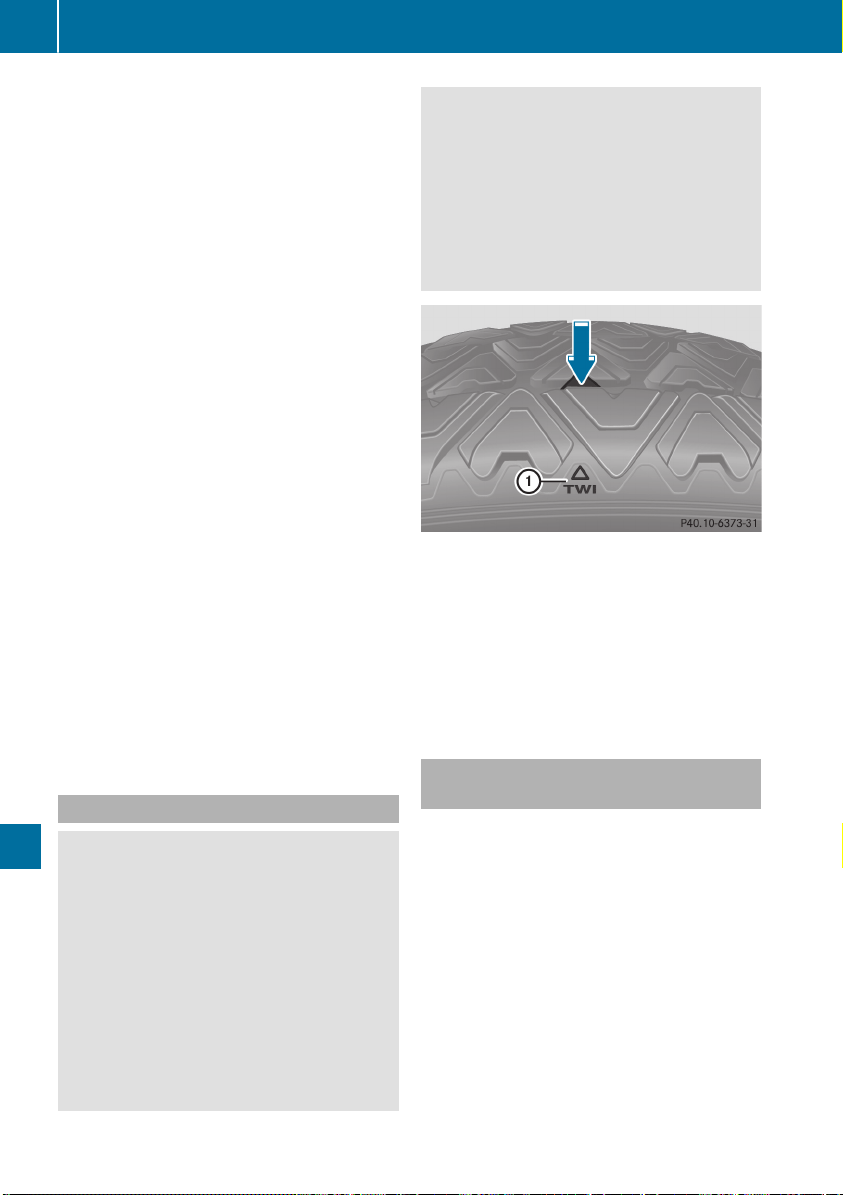Loading ...
Loading ...
Loading ...

Check wheels and tires for damage at least
once a month. Check wheels and tires after
driving off-road or on rough roads. Damaged
wheels can cause a loss of tire pressure. Pay
particular attention to damage such as:
R
cuts in the tires
R
punctures in the tires
R
tears in the tires
R
bulges on tires
R
deformation or severe corrosion on wheels
Regularly check the tire tread depth and the
condition of the tread across the whole width
of all tires (Y page 268). If necessary, turn the
front wheels to full lock in order to inspect the
inner side of the tire surface.
All wheels must have a valve cap to protect
the valve against dirt and moisture. Do not
mount anything onto the valve other than the
standard valve cap or other valve caps
approved by Mercedes-Benz for your vehicle.
Do not use any other valve caps or systems,
e.g. tire pressure monitoring systems.
Regularly check the pressure of all the tires
particularly prior to long trips. Adjust the tire
pressure as necessary (Y page 270).
Observe the notes on the emergency spare
wheel (Y page 293).
The service life of tires depends, among other
things, on the following factors:
R
Driving style
R
Tire pressure
R
Distance covered
Notes on tire tread
G
WARNING
If there is insufficient tire tread, the tire trac-
tion decreases. The tire tread is no longer
able to dissipate water. This increases the
risk of hydroplaning when the road surface
is wet, particularly when the vehicle's speed
is not adapted to the road conditions. There
is a risk of an accident.
When the tire pressure is too high or too
low, tires may wear differently at different
points on the tire tread. Therefore, regularly
check the tire tread depth and the condition
of the tread across the whole width of all
tires.
Minimum tire tread depth on:
R
Summer tires: â in (3 mm)
R
M+S tires: ã in (4 mm)
For safety reasons, have the tires replaced
before they reach the legally prescribed min-
imum tire tread depth.
Marking : shows where the bar indicator for
tread wear (arrow) is integrated into the tire
tread.
Treadwear indicators (TWI) are required by
law. Six indicators are positioned on the tire
tread. They are visible once a tread depth of
approximately á in (1.6 mm) has been
reached. If this is the case, the tire is so worn
that it must be replaced.
Selecting, mounting and replacing
tires
Tires and wheels
R
Only mount tires and wheels of the same
type and make.
Exception: it is permissible to mount a dif-
ferent type or make in the event of a flat
tire. Observe the "MOExtended tires (tires
with run-flat characteristics)" section
(Y page 253).
R
Only mount tires of the correct size onto the
wheels.
R
Break in new tires at moderate speeds for
the first 60 miles (100 km). The new tires
only reach their full performance after this
distance.
268
Operation
Wheels and tires
Loading ...
Loading ...
Loading ...